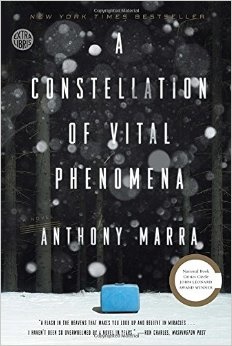 I had another novel in mind for my last haunting book review this month, but then I read A Constellation of Vital Phenomena, by Anthony Marra, and it immediately became the most haunting book I’ve read this year.
I had another novel in mind for my last haunting book review this month, but then I read A Constellation of Vital Phenomena, by Anthony Marra, and it immediately became the most haunting book I’ve read this year.
A Constellation of Vital Phenomena is the story of the impact of the Chechnyan wars on the people of a small village. The citizens of this village show all the humanity and inhumanity of how people behave under stress. The story revolves around a man’s abduction by Russian soldiers while his eight-year-old daughter Havaa watches. Her neighbor Akhmed takes her to an abandoned hospital where only one doctor, a weary woman named Sonja, remains to treat the victims of war and illness. Sonja, already overwhelmed by the work of running a hospital single-handedly, does not want to assume responsibility for Havaa.
The novel’s timeline takes place over five days, but through numerous flashbacks we see the impact of both the first and second Chechnyan wars on the characters and their families. The flashbacks give the novel a broader scope than simple narration of the five days of Havaa, Akhmed and Sonja’s lives could have. The story is both small and universal, as any good novel should be.
Marra’s prose is beautiful, even as the events he depicts are horrifying. We see torture and sex trafficking, drug abuse and lust, betrayal and euthanasia. Each tragedy makes sense in its time and in the connections between the characters, even as the horror of the novel’s totality mounts.
The novel’s title comes from a definition in Sonja’s medical dictionary:
“Life: a constellation of vital phenomena—organization, irritability, movement, growth, reproduction, adaptation.”
And, indeed, the novel is about life and all its vital phenomena. Ultimately, we see the power of love and compassion amidst the ugliness of war, but to say any more would be a spoiler.
SPOILER ALERT— THE REST OF THIS POST DISCUSSES THE PLOT AND THEMES IN A CONSTELLATION OF VITAL PHENOMENA.
Some of the characters in this book are heroes, but few are truly villains. Most are victims. They all lose family and friends, and many lose their self-respect as well. Some do their best during extraordinarily difficult times, and some discover their inability to act as they should.
Here are some of the key characters in the novel:
Havaa: At the heart of the novel is eight-year-old Havaa, whom Akhmed saves after her father Dokka is imprisoned by the Russians. As a child, she is not responsible for anything that happens to her, and caring for her drives many of the developments in the plot. Havaa also carries a secret that binds many of the characters and their pasts together.
Akhmed: Although only Havaa’s neighbor, Akhmed takes her to a hospital to save her, and agrees to work as a doctor in exchange for her care. He went to medical school, but is a far better artist than doctor. He is married to Ula, a woman with dementia, whom he mostly abandons to work in the hospital
Sonja: Sonja is a London-trained surgeon who returned to her native Chechnya to find her sister Natasha. She is bitter and exhausted because of her inability to care for everyone the war has sent her way.
Natasha: We see Natasha only in flashbacks. When war came to Chechnya, she fled and was caught up with sex-traffickers who also turned her into a drug addict. She returns, then flees again, and Sonja never finds out what happened to her, though the reader does.
Khassam: An old man and neighbor of Akhmed, Khassam tries to salvage what is left of his community when he cannot salvage his relationship with his son, an informant.
Ramzan: Ramzan, Khassam’s son, was tortured during the first Chechnyan war, and now informs on his friends and neighbors. He is troubled by his actions, and yet cannot find a way to extricate himself from the horrors and losses in his life.
Even when characters seek to escape their cruel reality, even when they betray their friends, I had to forgive them, because of the horrors they endured. Sonja has saved so many lives with her skill and lost her brilliant career; should I condemn her for her brusqueness toward a child who needs a home? Ramzan has been tortured and maimed; I condemn him for informing on his friend to avoid more torture? Akhmed saves Havaa and brings light to Sonja; should I condemn him for killing his bedridden and dying wife when he is about to be captured?
Anthony Marra does a masterful job at making readers ask these questions, of making us sympathize with people surrounded by cruelty who often become cruel themselves. His haunting prose is always cognizant of and compassionate toward human frailty.
A Constellation of Vital Phenomena is most like The Sandcastle Girls of the other haunting books I have reviewed, and also contains themes similar to the non-fiction Unbroken. We see the same inhumanity of man to other men that war brings out no matter where in the world and when in time it occurs.
This book is fiction, but its themes are real. It is a miracle that any of the characters in A Constellation of Vital Phenomena retained any scrap of goodness in the face of the evil around them. And those of us who live our lives away from evil cannot in our complacency hold the less fortunate responsible. Some of Marra’s characters believe they are beyond redemption, but we readers do not have to believe that they are.
Who are we to judge?




Very intriguing review, Theresa…thank you. I didn’t read the spoiler alert.